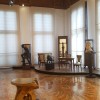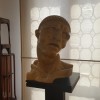From 9 May 2017, the Museum’s permanent collection will be enriched by the dialogue between the eighty-two masterpieces which the Carraro Foundation has donated to Ca’ Pesaro. Venice was always central to the lives of Chiara and Francesco, and at the same time represented a powerful source of inspiration in the course of their more than thirty-year-long journey as collectors.
The twentieth-century overview begins with early items of decorative art, together with a number of rare items of furniture created by the multitalented cabinetmaker Carlo Bugatti, which are presented alongside an extensive set of sitting-room furniture by another great artist, Eugenio Quarti.
These masterpieces of Italian Liberty style are surrounded by exceptional examples of glass art that Chiara and Francesco collected over the years, including many unique pieces by the Venetian Vittorio Zecchin, and others in iron and glass created by Umberto Bellotto and Artisti Barovier in the 1920s.
The historic works in glass are accompanied by a number of absolute masterpieces of sculpture, among them Adolfo Wildt’s Maria dà luce ai pargoli cristiani [The Mother of Christianity], and also paintings, such as three canvases by Antonio Donghi, the leading exponent of Magic Realism in Rome, including his 1934 masterpiece Le Villeggianti [The Vacationers], also known as Two Women on a Balcony,and Giorgio de Chirico’s La notte di Pericle [The Night of Pericles], painted in 1926.
The second room represents the most modern part of the collection, exemplified by the splendid works in glass made by Carlo Scarpa in the 1930s and 1940s, and the series created by Fulvio Bianconi and Archimede Seguso respectively.
As a counterpart, the walls bear two mature masterpieces by Giorgio Morandi and a rare oil painting by Gino De Dominicis. The space is occupied by two famous sculptures by Arturo Martini, Il bevitore [The Drinker] and La Pisana [The Pisan Woman], works that complete a reconsidered and truly exceptional look at the last century.
The virtually unknown and spectacular mural by Gino Severini from 1957, known as the Polittico Garagnani [Garagnani Polyptych], was made for a garage of the same name in Rome. It was restored by the Fondazione Chiara e Francesco Carraro on its arrival at Ca’ Pesaro and has never before been shown at an exhibition or public event.
The intervention has provided an opportunity to investigate the techniques used in the creation of the work, as well as the subsequent stages in which it was detached and its painted surface preserved, thus contributing important new material to twentieth-century art history.
Find out more about the Carraro Foundation >








